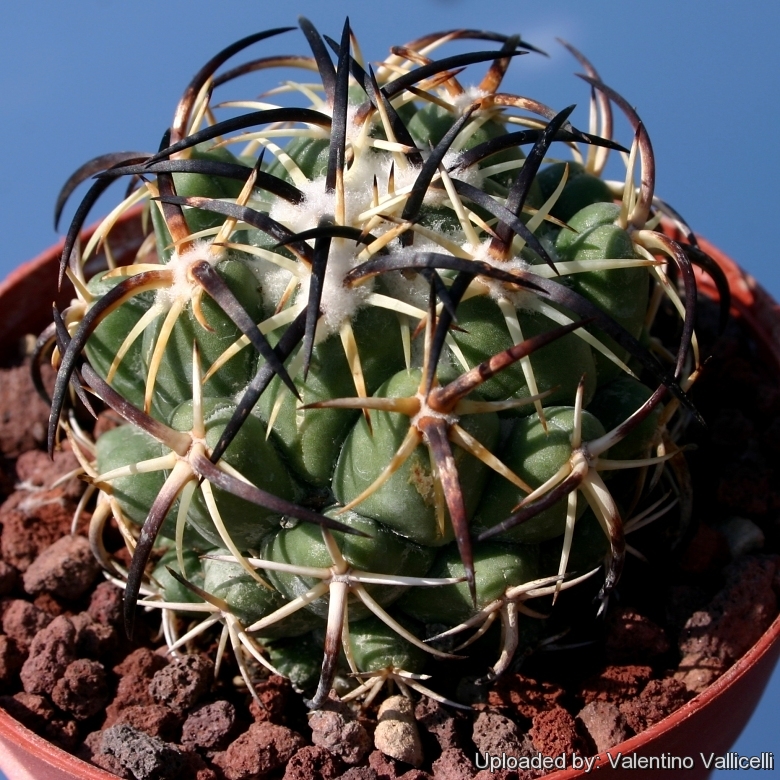
Coryphantha tripugionacantha Photo by: Valentino Vallicelli
This is one of strongest spined species.
Origin and Habitat: Mexico (Zacatecas in the region of San Juan Capistrano) At about 1000 m of elevation). It grows sympatrically with Echinocereus spinigemmatusSN|12016]]SN|31116]], Echinocereus pamanesiorumSN|31116]]SN|12016]], and Mammillaria, most possibly obscure, Mammillaria obscuraSN|12786]]SN|12786]].
Notes: The plant was found in nature by José Barron (a pupil of the local missionary school).
Synonyms:
Description: Usually solitary globose cactus, but often small groups are formed by underground stolons.
Stem: Globose, somewhat depressed apically, blue green when young, later dull green, up to 9 cm in height and width.
Tubercles: Flattened, more or less rounded, up to 20 mm high. Axil is woolly at first, later naked, without glands.
Roots: It has a huge taproot.
Central spines: 3, very stout, curved inward, grey with dark tips, radiating. 18-20 mm, radiating, lower one longest.
Radial spines: 8-9 radiating, curved inward, unequal, brownish grey, 8-9 mm long.
Flowers: Creamy yellow, 6-7 cm in diameter
Fruits: Oblong, juicy, opaque green. Up to 35 mm long.
Notes: Coryphantha tripugionacanthaSN|10262]]SN|10423]] belongs to the group of plants related to Coryphantha pallidaSN|10423]]SN|10262]], characterized by great yellow flowers without visible glands in the furrows of tubercles.
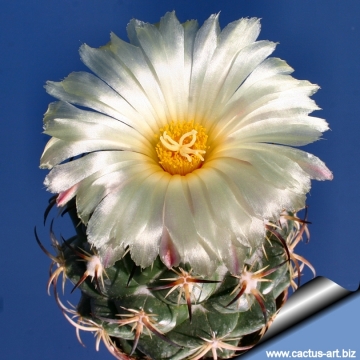 Coryphantha tripugionacantha Photo by: Cactus Art
Coryphantha tripugionacantha Photo by: Cactus Art L1464 San Juan Capistrano, Zacatecas, MX, Altitude: 1000m. Grows with Echinocereus pamanesiorum, Echinocereus spinigemmatus. Photo by: Valentino Vallicelli
L1464 San Juan Capistrano, Zacatecas, MX, Altitude: 1000m. Grows with Echinocereus pamanesiorum, Echinocereus spinigemmatus. Photo by: Valentino Vallicelli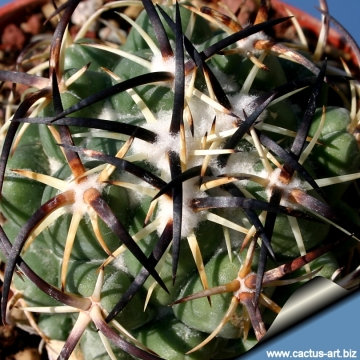 Coryphantha tripugionacantha Photo by: Cactus Art
Coryphantha tripugionacantha Photo by: Cactus Art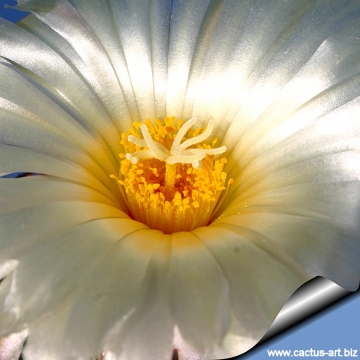 Coryphantha tripugionacantha Photo by: Cactus Art
Coryphantha tripugionacantha Photo by: Cactus Art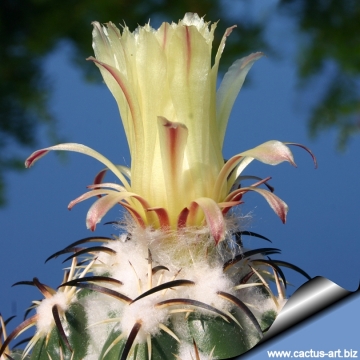 Coryphantha tripugionacantha Photo by: Cactus Art
Coryphantha tripugionacantha Photo by: Cactus Art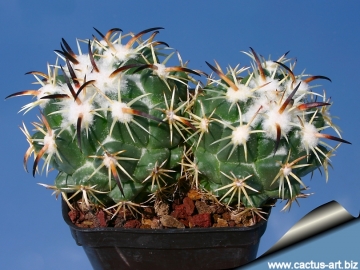 Coryphantha tripugionacantha Photo by: Cactus Art
Coryphantha tripugionacantha Photo by: Cactus Art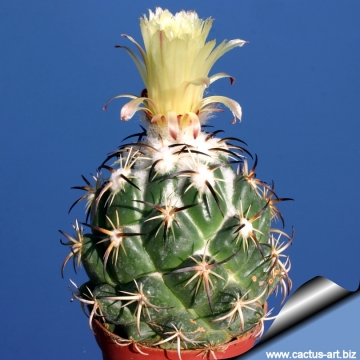 Coryphantha tripugionacantha Photo by: Cactus Art
Coryphantha tripugionacantha Photo by: Cactus Art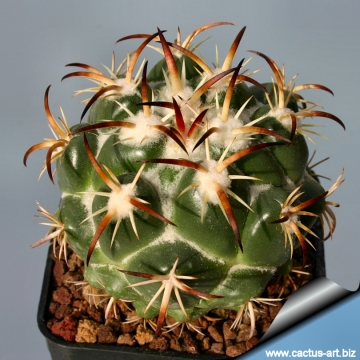 Coryphantha tripugionacantha Photo by: Cactus Art
Coryphantha tripugionacantha Photo by: Cactus ArtCultivation and Propagation: In culture Coryphantha tripugionacanthaSN|10423]]SN|10423]] is without problems and regularly shows its large yellow flowers. It is a summer-growing species of easy cultivation but sensitive to overwatering (rot prone).
Growth rate: Slow growing. It needs about 8-12 years to reach the typical, definite outlook.
Soil: Grow it in an open sandy-gritty cactus compost.
Pots: It needs a relatively shallow pot to accommodate its fibrous roots and provide a very good drainage. They may stay in the same pot for many years.
Watering: Water in moderation, it prefer a completely dry place during winter. Mature individuals easily rot and die especially after planting so be extremely cautious with watering. Keep dry in winter or when night temperatures remain below 10° C. Water it less than average if in bigger pots.
Special need: Provide very good ventilation. Nearly all problems occur as a result of overwatering and poor ventilation, especially when weather conditions are dull and cool or very humid.
Fertilization: Feed them once during the growing season with a fertilizer specifically formulated for cactus and succulents (high potash fertilizer with a dilute low nitrogen), including all micro nutrients and trace elements diluted to ½ the strength recommended on the label. They thrive in poor soils and need a limited supplies of fertilizer to avoid the plants developing excess vegetation, which is easily attacked by fungal diseases.
Exposure: It will do its best with lots of sun and become stressed with inadequate light which could result in poor growth and unnatural shape.
Hardiness: It likes warmth (recommended minimum winter temperature 5° C) however plants kept perfectly dry can can survive low temperatures, approx. -5°, but for safe cultivation it is best to avoid freezing temperatures.
Use: It can be cultivated outdoors in raised beds, terraces if sheltered from winter rain.
Pests & diseases: These cacti may be attractive to a variety of insects, but plants in good condition should be nearly pest-free, particularly if they are grown in a mineral potting-mix, with good exposure and ventilation. Nonetheless, there are several pests to watch for:
- Red spiders: Red spiders may be effectively rubbed up by misting the plants from above.
- Mealy bugs: Mealy bugs occasionally develop aerial into the new growth and flowers with disfiguring results, but the worst types develop underground on the roots and are invisible except by their effects.
- Rot: Rot is only a minor problem if the plants are watered and “aired” correctly. If they are not, fungicides won't help all that much.
Propagation: Seeds. The seeds can be sown in pots of fine, well-drained sandy soil, any time during the spring when temperatures are warm. Cover the seeds with a fine layer of grit and water from below with a fungicide to prevent damping off. For the 1-2 weeks cover the pots with a sheet of glass/clear perspex to keep the humidity levels high. Remove the glass and replace it with light shade-cloth and mist once or twice a day for the next two weeks after which most seeds should have germinated. From then on mistings can be reduced to every second and then every third day as the little plants grow.


















